| Latest | Greatest | Lobby | Journals | Search | Options | Help | Login |
|
|
|
This topic is archived. |
| Home » Discuss » Topic Forums » Sports |
|
| Jack Rabbit
|
Sun Mar-01-09 03:23 PM Original message |
| The Jack Rabbit Chess Report (March 1): Topa to challenge Vishy-Wrap on Aeroflot-Gris leads Linares |
|
Edited on Sun Mar-01-09 03:39 PM by Jack Rabbit
Topalov defeats Kamsky for right to challenge Anand
 Former FIDE world champion Veselin Topalov defeated Russo-American grandmaster Gata Kamsky 4�-2� in their candidates' match completed in Sofia Thursday. Topalov defeated Kamsky in seven games of the best-of-eight affair. Topalov won the seventh game of the match after Kamsky, who had the better of it for much of the day, faltered in the late going after taking 30 minutes to make a single move, resulting in severe time trouble. Topalov will challenge the reigning world champion, grandmaster Vishy Anand of India, to a match for the title to be held later this year. Bacrot, Moiseenko win Aeroflot Open  French granmster Etienne Bacrot and Slovenian GM Alexander Moiseenko shared first place in the prestigious Aeroflot Open after winning their respective final round games Wednesday in Moscow. M. Bacrot was declared the tournament champion based on superior tie break points. He will compete in this summer's Dortmund Sparkassen. Both players entered Wednesday's competition tied for second place behind Armenian grandmaster Arman Pashikian, who took over sole possession of first place in yesterday's eighth round when he defeated grandmaster Igor Kurnosov of Russia, who had been leading or sharing the lead for most of the week. Bacrot, playing Black, defeated Pashikian Wednesday in 62 moves while Moiseenko, with White, got the better of China's Zhou Weiqi in 48 moves. In other Aeroflot news, Russian IM Tatiana Kosintseva, one of only three women competing at the Aeroflot, scored 5� points and a performance rating of 2702. This appears good enough for Tanya to receive a grandmaster norm. Top seed Shakhiyar Mamedyarov withdrew from the tournament after losing to Kurnosov in just 21 moves in round 6 on Sunday. Mamedyarov, miffed that Kurnosov left the table after every move, accused his opponent of cheating by getting assistance from the Rybka computer program in the men's room. However, Kurnosov was never seen in the men's room during the game, but was seen outside the playing hall smoking. Moveover, the game was in the realm of theory for a full sixteen moves and the matching matching of Kurnosov's moves with Rybka were just as likely part of Kurnosov's home preparation. The protest was disallowed. Grischuk leads in Linares 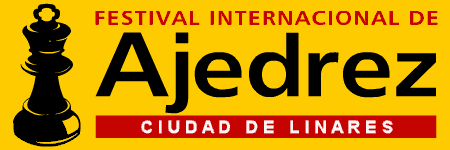 Grandmaster Alexander Grischuk of Russia leads the 26th Cuidad de Linares Tournament in the Andalucian mining town of Linares after nine rounds with 6 points. Grischuk has won three games and drawn six. Grischuk is followed by a trio in a tie for second place: Levon Aronian (Armenia), Vassily Ivanchuk (Ukraine) and Magnus Carlsen (Norway). In today's action, Magnus, playing Black, defeated Cuban grandmaster Leinier Dom�nguez in 54 moves and all other games were drawn. The tenth round will be played tomorrow. The last day off for the players is Wednesday. The fourteen-round event, sometimes call the Wimbledon of Chess, is scheduled to end Saturday. Social Page: Lahno-Fontaine Nuptuals  Ukrainian grandmaster Katya Lahno married French grandmaster Robert Fontaine in Mairie de Besan�on Wedneday afternoon. Congratulations joyous wishes to the happy couple. Calendar Cappelle la Grande Open 28 February-7 March. Reykjavik Open 4-13 March. European Individual Championships, Budva (Montenegro) 5-19 March. Women's Grand Prix, Istanbul 6-20 March. Koneru, Hou Yifan, Stefanova, Cramling, Sebag, Chibudanidze, Zhao Xue, Danielian, Shen Yang, Z. Mamedyarova, Yildiz. Melody Amber Rapid/Blind Tournament, Nice 13-27 March. Dubai Open 3-13 April. Gausdal Chess Classic (Norway) 7-15 April. Foxwoods Open, Mashantucket, Connecticut 8-12 April. Russian Club Cup (Team Championships), Sochi 30 April-12 May. US Chess Championship, St. Louis May. Exact dates TBA. MTel Masters, Sofia 9-19 May. Asian Championships, Subic Freeprot (The Philippines) 12-23 May. Chicago Open 22-25 May. Aerosvit International Tournament, Foros (Ukraine) 9-20 June. World Open, Philadelphia 29 June-5 July. Canadian Open, Edmonton 11-19 July. Czech Open, Pardubice 16 July-2 August. Biel Chess Festival 18-31 July. FIDE Grand Prix, Yerevan. 8-24 August. |
| Printer Friendly | Permalink | | Top |
| Jack Rabbit
|
Sun Mar-01-09 03:24 PM Response to Original message |
| 1. This week's games |
|
Edited on Sun Mar-01-09 04:05 PM by Jack Rabbit
Your humble hare acknowledges the assistance of Fritz 6.0 on analysis. Diagrams on the Jack Rabbit Chess Report are made with Chess M�rida, a true type font that can be downlaoded free here. !""""""""# $tMvWlVmT% $OoOoOoOo% $ + + + +% $+ + + + % $ + + + +% $+ + + + % $pPpPpPpP% $RnBqKbNr% /(((((((() WHITE White to move (This position is a theoretical draw) |
| Printer Friendly | Permalink | | Top |
| Jack Rabbit
|
Sun Mar-01-09 03:26 PM Response to Reply #1 |
| 2. Topalov - Kamsky, Candidates' Match, Round 5, Sofia |
 Veselin Topalov Veselin Topalov - Gata Kamsky Candidates' Match, Round 5 Sofia, 23 February 2009 French Exchange Game: Tarrasch Opening 1.e4 e6 2.d4 d5 3.Nd2
3...c5 4.Ngf3
4...cxd4 5.Nxd4
5...Nc6
6.Bb5
6...Bd7 7.Nxc6 Bxc6
8.Bxc6+ bxc6 9.c4 Bd6
!""""""""# $t+ Wk+mT% $O + +oOo% $ +oVo+ +% $+ +o+ + % $ +p+p+ +% $+ + + + % $pP n PpP% $R BqK +r% /(((((((() WHITE: Veselin Topalov Position after 9...Bf8d6 10.cxd5!?
10...cxd5 11.exd5 exd5
12.0-0 Ne7 13.Nf3
13...0-0 14.Qd3 Qd7
15.Rd1 Rfd8 16.Be3 a5
!""""""""# $t+ T +l+% $+ +wMoOo% $ + V + +% $O +o+ + % $ + + + +% $+ +qVn+ % $pP + PpP% $R +r+ K % /(((((((() WHITE: Veselin Topalov Position after 16...a7a5 17.g3
17...h6 18.Bb6 Rdc8 19.Bd4 Bc5
20.Bc3 Bb4
21.Be5 Bd6 22.Rd2
22...Bxe5
23.Nxe5 Qd6 24.Re1 Rc7 25.Qf3
25...Rf8
26.Kg2 Rb7 27.h4
27...Qb4 28.Ree2 Qa4 29.b3 Qb4 30.Nd3 Qd6 31.h5
31...Rc7 32.Nf4 d4!?
33.Re4
33...Nc6 34.Nd3!
34...Rd8 35.Rc2
35...Nb4?
!""""""""# $ + T +l+% $+ T +oO % $ + W + O% $O + + +p% $ M Or+ +% $+p+n+qP % $p+r+ Pk+% $+ + + + % /(((((((() WHITE: Veselin Topalov Position after 35...Nc6b4 36.Nxb4!
36...axb4 37.Rxd4!
37...Qf8
38.Rxd8 Qxd8 39.Rxc7 Qxc7 !""""""""# $ + + +l+% $+ W +oO % $ + + + O% $+ + + +p% $ O + + +% $+p+ +qP % $p+ + Pk+% $+ + + + % /(((((((() WHITE: Veselin Topalov Position after 39...Qd8c7:R 40.Qa8+!
40...Kh7 41.Qe4+ Kg8 42.Qxb4!
42...Qc6+ 43.Kg1 Qc1+ 44.Kh2 Qc2
45.Qe1
45...Kf8 46.a3 Qb2 47.Qb4+ Kg8 48.Kg2 Qe5 49.Qg4
49...Qb2
50.Qc8+ Kh7 51.Qc4 Qxa3 52.Qxf7 Qb4 53.Qc4 Qb7+ 54.Kg1 Qf3 55.g4 1-0
|
| Printer Friendly | Permalink | | Top |
| Jack Rabbit
|
Sun Mar-01-09 03:29 PM Response to Reply #1 |
| 3. Pashikian - Bacrot, Aeroflot Open, Round 9, Moscow |
 Etienne Bacrot Arman Pashikian - Etienne Bacrot Aeroflot Open, Round 9 Moscow, 25 February 2009 Semi-Slav Queen's Gambit: Marshall Opening 1.d4 d5 2.c4 e6 3.Nc3 c6 4.e4
4...Bb4
5.exd5 exd5 6.cxd5 cxd5 7.Bb5+!?
7...Bd7
8.Bd3 Ne7
9.Qf3 Qc8
10.Nge2 Bf5
11.0-0 Bxd3 12.Qxd3 0-0 13.Qb5
13...Bxc3 14.bxc3
14...Rd8 15.Ba3 Nbc6 16.Bxe7
16...Nxe7 17.a4
17...a6 18.Qb4 Ng6 19.Rab1 Rb8
20.a5 h5 21.Qa4 h4 22.h3 Re8 23.Rb2?!
23...Re4 24.c4
!""""""""# $ Tw+ +l+% $+o+ +oO % $o+ + +m+% $P +o+ + % $q+pPt+ O% $+ + + +p% $ R +nPp+% $+ + +rK % /(((((((() WHITE: Arman Pashikian Position after 24.c3c4 24...dxc4?!
25.Rc1 Qf5 26.Qc2
26...Nf4 27.Nc3
27...Nd3 28.Nxe4 Nxc1 29.Qxc4
29...Qxe4 30.Qxc1 Rd8 31.Rb4 Rd6
32.Qe3 Qd5 33.Qf4
33...Re6
34.Kh2?!
!""""""""# $ + + +k+% $+o+ +oO % $o+ +t+ +% $P +w+ + % $ T P Q O% $+ + + +p% $ + + PpK% $+ + + + % /(((((((() WHITE: Arman Pashikian Position after 34.Kg1h2 34...Rg6!
35.Qb8+
35...Kh7 36.Qxb7 Rxg2+ 37.Kh1 Qxb7 38.Rxb7 Rxf2 39.Ra7
39...Rf6 40.Kg2 Kg6 41.Rb7?
!""""""""# $ + + + +% $+r+ +oO % $o+ + Tl+% $P + + + % $ + P + O% $+ + + +p% $ + + +k+% $+ + + + % /(((((((() WHITE: Arman Pashikian Position after 41.Ra7b7 41...Rf4
42.d5
42...Rf5 43.Rb6+ f6 44.Rd6 Kh6
45.Rd8 Kh7 46.Rd7 Rg5+ 47.Kf2 Rg3 48.Rd6
48...Rd3!
49.Ke2
!""""""""# $ + + + +% $+ + + Ol% $o+ R O +% $P +p+ + % $ + + + O% $+ +t+ +p% $ + +k+ +% $+ + + + % /(((((((() WHITE: Arman Pashikian Position after 49.Kf2e2 49...Rxh3!
50.Rxa6 Rg3!
51.Rb6 h3 52.Kf2 h2!
53.Rb1
53...Ra3!
54.Rd1
54...Rxa5 55.Kg2 Ra2+ 56.Kh1 Kg6 57.d6 Ra8!
58.Kxh2 Rd8 59.Kg3
59...Kf5 60.Kf3 Rd7 61.Rg1 Ke6
62.Ke4 g5 0-1 !""""""""# $ + + + +% $+ +t+ + % $ + PlO +% $+ + + O % $ + +k+ +% $+ + + + % $ + + + +% $+ + + R % /(((((((() WHITE: Arman Pashikian Final position 62...g7g5
|
| Printer Friendly | Permalink | | Top |
| Jack Rabbit
|
Sun Mar-01-09 03:31 PM Response to Reply #1 |
| 4. Pashikian - Kurnosov, Aeroflot Open, Round 8, Moscow |
|
Edited on Sun Mar-01-09 03:39 PM by Jack Rabbit
Armenian grandmaster Arman Pashikian defeated Russian GM Igor Kurnosov in the next-to-last round to take sole possession of first place in the Aeroflot Open.
 Arman Pashikian Arman Pashikian - Igor Kurnosov Aeroflot Open, Round 8 Moscow, 24 February 2009 West India Game: Indian Queen's Game (Russian Opening) (Gr�nfeld Defense) 1.d4 Nf6 2.c4 g6 3.Nc3 d5 4.Qb3
4...dxc4 5.Qxc4 Bg7 6.e4 0-0 7.Nf3 a6
8.Qa4
8...Bg4
9.Be3
9...Nfd7!?
10.Qb3!
10...b5 11.Be2 Nc6 12.Rd1 Nb6
13.e5 Nc4 14.0-0 N6a5?
15.Qb4 Rc8 16.Bg5
16...f6
!""""""""# $ +tW Tl+% $+ O O Vo% $o+ + Oo+% $Mo+ P B % $ QmP +v+% $+ N +n+ % $pP +bPpP% $+ +r+rK % /(((((((() WHITE: Arman Kurnosov Position after 16...f7f6 17.b3!
17...fxg5
18.bxc4 Bxf3 19.Bxf3 Nxc4 20.Bd5+
20...Kh8 21.Bxc4
21...bxc4 22.Qxc4 c5 23.dxc5 Qc7
24.Ne4 Qxe5
25.Rd5 Qf4 26.g3
26...Qg4 27.Rxg5 Qf3 28.Rd5 Rc6 29.Re1
29...h6 30.Re3 Qf7
31.Kg2 g5 32.h3 Re6
33.Rd2 Qg6
34.Rd5 Qf7 35.Rd7 Qf5
36.Rd2 Qg6 37.a3 Re5
!""""""""# $ + + T L% $+ + O V % $o+ + +wO% $+ P T O % $ +q+n+ +% $P + R Pp% $ + R Pk+% $+ + + + % /(((((((() WHITE: Arman Kurnosov Position after 37...Re6e5 38.c6!
38...Qe6 39.Rc2 Rc8 40.c7
40...Qxc4 41.Rxc4 Kg8 42.Rd3
42...Rf5
43.Rd7 Rf7 44.Nc5! 1-0 !""""""""# $ +t+ +l+% $+ PrOtV % $o+ + + O% $+ N + O % $ +r+ + +% $P + + Pp% $ + + Pk+% $+ + + + % /(((((((() WHITE: Arman Kurnosov Final position after 44.Ne5c5
|
| Printer Friendly | Permalink | | Top |
| Jack Rabbit
|
Sun Mar-01-09 03:35 PM Response to Reply #1 |
| 5. T. Kosintseva - Milov, Aeroflot Open, Round 5, Moscow |
|
Edited on Sun Mar-01-09 03:36 PM by Jack Rabbit
Tantiana Kosintseva appears to have earned a grandmaster norm and gotten her rating back over 2500 for her 5� points at the Aeroflot. If so, congratulations, Tatiana Alexeyevna.
 Tatiana Kosintseva Tatiana Kosintseva - Vadim Milov Aeroflot Open, Round 5 Moscow, 21 February 2009 Moorish Game: Little Dragon Defense (Robatsch Defense) 1.e4 d6 2.d4 g6
3.Nc3 Bg7 4.Be3 c6
5.Qd2 b5 6.Bd3
6...Nd7 7.Nf3 Bb7
8.0-0 a6
9.a4 b4
10.Ne2 c5 11.Ng3 Qc7!?
12.c3!?
12...bxc3?!
13.bxc3
13...Ngf6
!""""""""# $t+ +l+ T% $+vWmOoVo% $o+ O Mo+% $+ O + + % $p+ Pp+ +% $+ PbBnN % $ + Q PpP% $K + +rK % /(((((((() WHITE: Tatiana Kosintseva Position after 13...Ng8f6 14.Bh6!
14...0-0
15.Bxg7 Kxg7 16.d5!?
16...e5
17.dxe6
17...fxe6 18.Ng5 Rae8
19.f4 c4 20.Bc2 e5 21.f5 Nc5
22.Rad1?
!""""""""# $ + T T +% $+vW + Lo% $o+ O Mo+% $+ M OpN % $p+o+p+ +% $+ P + N % $ +bQ +pP% $+ +r+rK % /(((((((() WHITE: Tatiana Kosintseva Position after 22...Ra1d1 22...Rd8?!
23.Qe2!
23...Qe7
24.Qxc4!
24...Ng4!
25.Ne6+ Nxe6 26.Qxe6 Qh4!
27.f6+ Kh8?
28.h3!
28...Ne3 !""""""""# $ + T T L% $+v+ + +o% $o+ OqPo+% $+ + O + % $p+ +p+ W% $+ P M Np% $ +b+ +p+% $+ +r+rK % /(((((((() WHITE: Tatiana Kosintseva Position after 28...Ng4e3 29.Qe7!
29...Qh6 30.Qxb7 Nxc2
31.Rf3 Rb8
32.Qxa6 Rb2 33.Qa7 Kg8
!""""""""# $ + + Tl+% $Q + + +o% $ + O PoW% $+ + O + % $p+ +p+ +% $+ P +rNp% $ Tm+ +p+% $+ +r+ K % /(((((((() WHITE: Tatiana Kosintseva Position after 33...Kh8g8 34.Nf5!!
34...gxf5 35.Rg3+ Kh8 36.Qg7+! 1-0
|
| Printer Friendly | Permalink | | Top |
| Jack Rabbit
|
Sun Mar-01-09 03:38 PM Response to Reply #1 |
| 6. Endgame: Ponkratov - Moiseenko, Aeroflot Open, Round 5, Moscow |
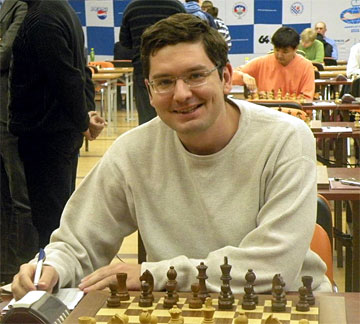 Alexander Moiseenko Pavel Ponkratov - Alexander Moiseenko Aeroflot Open, Round 5 Moscow, 21 February 2009 !""""""""# $ + + + +% $+ + +tL % $ +rO +o+% $+w+ Om+ % $oP Vq+ P% $P + +bP % $ +r+ +k+% $+ + + + % /(((((((() WHITE: Pavel Ponkratov Position after 50...Be3d4
51.Re2??
51...d5!
52.Qc2
52...e4!
53.Bxe4
53...Ne3+ 0-1
|
| Printer Friendly | Permalink | | Top |
| Jack Rabbit
|
Sun Mar-01-09 03:42 PM Response to Reply #1 |
| 7. Grischuk - Aronian, Round 6, Linares |
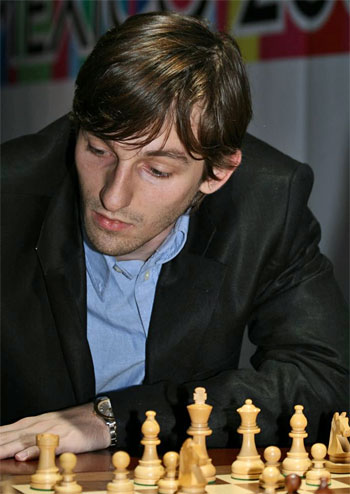 Alexander Grischuk Alexander Grischuk - Levon Aronian 26th Ciudad de Linares, Round 6 Linares, 25 February 2009 Semi-Slav Queen's Gambit: Anti-Meran Gambit (Moscow Defense) 1.d4 d5 2.c4 c6 3.Nf3 Nf6 4.Nc3 e6 5.Bg5 h6
6.Bh4 dxc4 7.e4 g5 8.Bg3 b5 9.Ne5
9...h5 10.h4 g4 11.Be2 Bb7 12.0-0 Nbd7 13.Qc2
13...Nxe5 14.Bxe5 Bg7 15.b3
15...0-0!?
16.bxc4
16...Nh7 17.Bxg7 Kxg7 18.Rad1
18...Qxh4
19.cxb5 cxb5 20.Nxb5 Rac8
21.Qd3 Rfd8
22.d5
22...exd5 23.Qd4+ Kg8
24.Qxa7 Qe7?!
!""""""""# $ +tT +l+% $Qb+ Wo+m% $ + + + +% $+n+o+ +o% $ + +p+o+% $+ + + + % $p+ +bPp+% $+ +r+rK % /(((((((() WHITE: Alexander Grischuk Position after 24...Qh4e7 25.e5!
25...Qxe5
26.Qxb7 Rb8 27.Qc7 Qxe2 28.Nd4!
28...Qc4
29.Qe5 Re8 30.Qxh5
30...Rb6
31.Nf5 Rbe6?!
32.Ne3
32...Qxa2 33.Nxg4 Qe2
!""""""""# $ + +t+l+% $+ + +o+m% $ + +t+ +% $+ +o+ +q% $ + + +m+% $+ + + + % $ + +wPp+% $+ +r+rK % /(((((((() WHITE: Alexander Grischuk Position after 33...Qa2e2 34.Qh4?!
34...Qc4!?
35.f4!?
35...Rg6
36.Rf3
36...Qc5+
37.Kh1 Qe7 38.Qh3 Qd6?
!""""""""# $ + +t+l+% $+ + +o+m% $ + W +t+% $+ +o+ + % $ + + Pn+% $+ + +r+q% $ + + +p+% $+ +r+ +k% /(((((((() WHITE: Alexander Grischuk Position after 38...Qe7d6 39.f5!
39...Rg5 40.Nh6+ Kf8
41.Nxf7!
41...Qf6
42.Nxg5 Nxg5 43.Qh4
43...Re7 44.Rh3 Qxf5
45.Qh8+ Kf7 46.Rh5 Re8
47.Qh6 Rg8 48.Qd6 Rg6 !""""""""# $ + + + +% $+ + +l+ % $ + Q +t+% $+ +o+wMr% $ + + + +% $+ + + + % $ + + +p+% $+ +r+ +k% /(((((((() WHITE: Alexander Grischuk Position after 48...Rg8g6 49.Qxd5+
49...Qxd5 50.Rxd5 Ne4
51.Rhf5+ Kg7 52.Rd7+ Kh6 53.Rf4 Ng3+
54.Kh2 Nh5 55.Ra4 Nf6 56.Rdd4 Rg5 57.Rf4 Rg6
58.Rf3 Nh7 59.Rh3+! 1-0
|
| Printer Friendly | Permalink | | Top |
| Jack Rabbit
|
Sun Mar-01-09 03:47 PM Response to Reply #1 |
| 8. Ivanchuk - Anand, Round 5, Linares |
|
The world champion varied from one of his own previous games to introduce a novelty that left much to be desired. He ended up fighting for a draw and getting it with a marvelously instructive endgame.
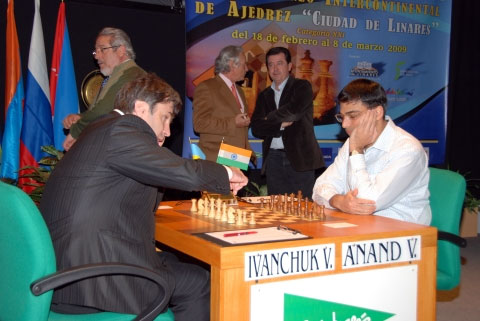 Vassily Ivanchuk and Vishy Anand at the start of the present game Vassily Ivanchuk - Vishy Anand 26th Ciudad de Linares, Round 5 Linares, 24 February 2009 Slav Queen's Gambit: Karlsbad Defense 1.d4 d5 2.c4 c6 3.Nf3 Nf6 4.Nc3 dxc4 5.a4 Bf5 6.e3 e6 7.Bxc4 Bb4 8.0-0 0-0 9.Qe2
9...Nbd7
10.e4 Bg6 11.Bd3 Bh5 12.e5
12...Nd5 13.Nxd5
13...cxd5 14.Qe3 Re8
15.Ne1
15...Bg6
16.Bxg6
16...hxg6 17.Nd3 Qb6 18.Nxb4
18...Qxb4 19.b3 Rac8 20.Ba3 Qc3 21.Rac1 Qxe3
22.fxe3 f6 23.Bd6 a5!?
24.Bc7!
24...fxe5
25.dxe5 b6 26.Rc3
26...Rf8
27.Rfc1 Rf5?
!""""""""# $ +t+ +l+% $+ Bm+ O % $ O +o+o+% $O +oPt+ % $p+ + + +% $+pR P + % $ + + +pP% $+ R + K % /(((((((() WHITE: Vassily Ivanchuk Position after 27...Rf8f5 28.g4!
28...Rf7 29.Bd6 Nc5
30.Bxc5 bxc5 31.Rxc5 Rcf8
32.Rxa5!
32...Rf3 33.Ra7
33...g5
34.Re1 d4 35.exd4
35...Rxb3 36.Rf1
36...Rd3 37.Rxf8+
37...Kxf8 38.a5 Rxd4 39.h3 Kg8
40.a6 Ra4 41.Kf2?
41...Ra5!
42.Kf3 Rxe5 43.Re7 Kh7
44.Re8 Ra5
45.Rxe6 Ra3+!
46.Ke4!?
!""""""""# $ + + + +% $+ + + Ol% $p+ +r+ +% $+ + + O % $ + +k+p+% $T + + +p% $ + + + +% $+ + + + % /(((((((() WHITE: Vassily Ivanchuk Position after 46.Kf3e4 46...Rxh3!
47.Kd5
47...Rc3
48.Rb6 g6 49.Kd6
49...Kh6 50.Rb8 Ra3
51.Ra8
51...Kg7 52.Kc5
52...Ra1 53.Kb6 Rb1+!?
54.Ka7 Rb4 55.Rb8 Rxg4! !""""""""# $ R + + +% $K + + L % $p+ + +o+% $+ + + O % $ T + +p+% $+ + + + % $ + + + +% $+ + + + % /(((((((() WHITE: Vassily Ivanchuk Position after 55.Rb4g4:p
56.Rb5 Ra4 57.Rxg5
57...Rb4 58.Rc5 Kh6
59.Rc6 Kh5 60.Rb6 Rf4 61.Rb5+ g5 62.Kb6 Rf6+ 63.Ka5
63...Rf7 64.Kb6 Rf6+ 65.Ka5 �-� !""""""""# $ + + + +% $+ + + + % $p+ + T +% $Kr+ + Ol% $ + + + +% $+ + + + % $ + + + +% $+ + + + % /(((((((() WHITE: Vassily Ivanchuk Final position after 65.Kb6a5
|
| Printer Friendly | Permalink | | Top |
| cboy4
|
Sun Mar-01-09 11:15 PM Response to Original message |
| 9. This should be a huge violation, posting math problems on |
|
the sports -- key word: sports -- board.
|
| Printer Friendly | Permalink | | Top |
| Jack Rabbit
|
Mon Mar-02-09 03:51 AM Response to Reply #9 |
| 10. Math problems? |
|
I beg your pardon, sir. I post no math problems here.
as for your snarky remark suggesting that chess is not sport . . . You may be aware that through the dark night of the Bush years, when the US corporate media was in the tank for the regime, at leat until after Hurricane Katrina, one of the most trusted news sources on this website was and still is the UK Guardian. So, with that in mind, I give you this piece on the Guardian's online sport page. Read it and weep. |
| Printer Friendly | Permalink | | Top |
| cboy4
|
Mon Mar-02-09 04:58 AM Response to Reply #10 |
| 11. Chess is definitely not a sport .. the next thing you're going to |
|
tell me is crossword puzzles are a sport.
How about hop scotch. Is that a sport too? And I don't trust anything the British have to say about sports. LOL |
| Printer Friendly | Permalink | | Top |
| Jack Rabbit
|
Mon Mar-02-09 05:04 AM Response to Reply #11 |
| 12. I guess you don't trust Indians, either |
|
They named Vishy Anand sportsman of the year when he won the world championship in 2007.
By the way, did you know the world chess championship is older than any world boxing championship? Checkmate. |
| Printer Friendly | Permalink | | Top |
| cboy4
|
Mon Mar-02-09 05:12 AM Response to Reply #12 |
| 13. If I took a poll, a majority of sports fans would not consider |
|
chess a sport.
They would consider dodge ball more of a sport because it involves a ball. Your boxing comparison is therefore officially nullified. Sorry India. I win. 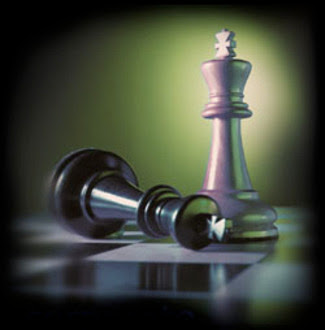 |
| Printer Friendly | Permalink | | Top |
| Jack Rabbit
|
Mon Mar-02-09 05:23 AM Response to Reply #13 |
| 14. Boxing doesn't involve a ball, either. |
|
Neither does track and field, unless you consider the shot put a ball. I'd like to see Barry Bonds hit that into McCovey Cove.
And if you took a poll of American about 1985 they would have told you Ronald Reagan was the greatest president since Lincoln. Checkmate. |
| Printer Friendly | Permalink | | Top |
| cboy4
|
Mon Mar-02-09 05:44 AM Response to Reply #14 |
| 15. Yes but presidents change over time, the basic concept of |
|
real sports do not, so my poll would be as accurate in 1985 as it would be in 2009.
And who could hit a shot put into McCovey Cove? That's correct.  Match Pointhttp://www.smh.com.au/ffximage/2007/11/21/federer1_wideweb__470x333,0.jpg |
| Printer Friendly | Permalink | | Top |
| Jack Rabbit
|
Mon Mar-02-09 12:18 PM Response to Reply #15 |
| 16. Ooops, the line judge just called that one back |
|
Edited on Mon Mar-02-09 12:26 PM by Jack Rabbit
presidents change over time, the basic concept of real sports do not . . . Begging the question. You're asserting as fact that which you are trying to prove. That's a fifteen yard penalty. We're going to tack on another five yards for that serious stretcher about Bonds being able to hit a shot put into McCovey Cove. Meanwhile, I have shown that chess is reported in the sport section of the UK Guardian and that Vishy Anand was named sportsman of the year by the Indian press. I could present many similar examples of periodicals reporting chess as sport or chess players being regarded as sports personalities. However, the periodicals would not typically be American periodicals nor the press associations American press associations. Typically, these are periodicals and press associations are overseas in places where polls showed the public had a better informed view of Mr. Bush's invasion of Iraq than Americans did in the middle of this decade. This discrepancy is simply another case of the American MSM misinforming its readers, listeners and viewers. You unfortunately have fallen for the American MSM's steer manure. Checkmate. |
| Printer Friendly | Permalink | | Top |
| cboy4
|
Tue Mar-03-09 06:50 AM Response to Reply #16 |
| 17. LOL |
|
I keep trying to think of a way to be a dick to you, but you're too funny and clever.
"Ooops, the line judge just called that one back" :rofl: "That's a fifteen yard penalty." "Meanwhile, I have shown that chess is reported in the sport section of the UK Guardian and that Vishy Anand was named sportsman of the year by the Indian press." :spray: Toooo much. But having said all of that, chess is most certainly not a sport. I'd say it's the equivalent of playing Grand Theft Auto on XBOX. It's a hobby. Good game, but I win. |
| Printer Friendly | Permalink | | Top |
| nickgutierrez
|
Tue Mar-03-09 10:42 AM Response to Reply #9 |
| 18. Where else would this fit? |
|
I enjoy these reports, I even play through most of the games myself. I simply don't reply some of the time because I follow a rule that you should consider: If you don't have anything relevant or important to say, shut up.
|
| Printer Friendly | Permalink | | Top |
| cboy4
|
Wed Mar-04-09 02:11 AM Response to Reply #18 |
| 19. Let's get this straight. Nick advocates shutting up on a message |
|
board, as opposed to weighing in and increasing the traffic at DU.
I mean, telling people they should shut up on a message board is like telling people they should not make any calls on their cell phone. Advocating silence on a message board is the making of an oxymoron. I bet even Jack Rabbit, who finally concedes that chess is most definitely not in a million years a sport, understands that. It's like telling a 18,997 packed into Staples Center in Los Angeles not to cheer when the Lakers score. No sense. |
| Printer Friendly | Permalink | | Top |
| Jack Rabbit
|
Wed Mar-04-09 02:38 AM Response to Reply #19 |
| 20. Who said I conceded that? |
|
I presented evidence that it is and you presented only bluster that it is not. Who do you think you are? A Bush White House talking head? That was their modus operandi.
I happen to agree with Dr. Emanuel Lasker, who was the world champion one hundred years ago, that chess is a fight. A game of chess is like a boxing match, only through the medium of the chess board, pawns and pieces the contestants determine who has the stronger mind, rather than the stronger body. Perhaps you are unaware that some boxers see the similarities, including Lennox Lewis and Wladimir Kletchko, who are both strong amateur chess players. Checkmate. |
| Printer Friendly | Permalink | | Top |
| cboy4
|
Wed Mar-04-09 03:13 AM Response to Reply #20 |
| 21. LOL. Apparently you think boxing is the only mainstream |
|
Edited on Wed Mar-04-09 03:24 AM by cboy4
sport, since it's all to which you compare your hobby/pastime/activity of chess.
Even though I'm fascinated you apparently watched Dr. Emanuel Lasker in person enough times to determine chess is a fight, that doesn't make it a sport. Rockem Sockem Robots is also a fight. 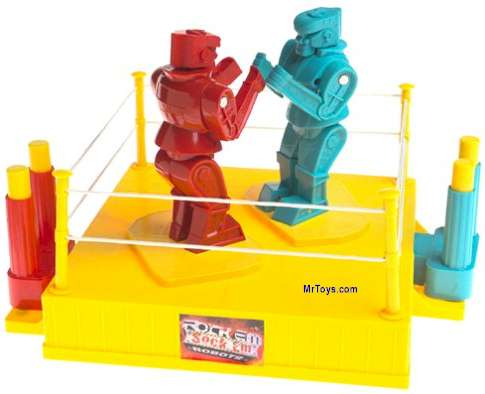 Is Rockem Sockem Robots a sport? Definitely the sport of boxing you admire. So... TKO in my favor. |
| Printer Friendly | Permalink | | Top |
| Jack Rabbit
|
Wed Mar-04-09 04:12 AM Response to Reply #21 |
| 22. TKO? |
|
You were checkmated ages ago. That's just unsportsmanlike conduct to keep hitting after the game is over. We'll have penalize you more yardage. That's half the distance to the goal line. You'd really be backed into a corner if you hadn't already lost.
Your argument that a child's toy isn't a sport, therefore chess is not a sport, is flawed. The reason the toy is not sport is because the robots don't think like humans or feel pain like humans. But when humans are in the ring (or at the chess board), it is a sport. And no, I don't consider chess a sport when the competitors are computer programs (although the programs make a great training tool). One does not have to physically watch Dr. Lasker (or Vishy Anand) play chess to appreciate the fight. Any chess fan would understand that. In fact, any chess fan would tell you that physically watching two grandmasters play is boring. I'd rather watch the grass grow. Nevertheless, even though Dr. Lasker died in 1941, you can still watch him play chess and, if you know anything about the game, enjoy the excitement and marvel at the brilliance. Just look here. You can see one of Lasker's greatest fights, blow by blow, over a hundred years after it was fought. You see, as a sport, chess is uniquely interactive. The chess fan is not a couch potato. The best way to watch a grandmaster game is online, in a community of other chess fans, discussing the game in progress. Even better when that discussion is led by a master or grandmaster, as was the case when ChessGames.com (a really cool website I can't recommend highly enough) broadcast the games of the recent Topalov-Kamsky match with the discussion conducted by British GM Nigel Short, who played and lost a championship match against Garry Kasparov in 1993. We (and Mr. Short) were thinking along with Topalov and Kamsky as they battled each other, try to come up with reasonable moves they might play and making judgments about those they did. |
| Printer Friendly | Permalink | | Top |
| cboy4
|
Wed Mar-04-09 07:26 AM Response to Reply #22 |
| 23. Are the people who ruled I was "checkmated ages ago" the |
|
same ones who insisted there were WMD's in Iraq?
Uh oh, looks like we're going to have to send you to the penalty box for five minutes.  I will say this. You're a fierce defender of your non-sport, and you're a very, very witty and entertaining writer. **Witty and entertaining writing .. that's more of a sport than chess** As you know, most sports fans would rather lay in front of a locomotive than be subjected to ESPN coverage of such a boring exhibition of I don't know what. Now if the participants started throwing punches or began taking steroids .. then we're getting somewhere!! :bounce: |
| Printer Friendly | Permalink | | Top |
| Jack Rabbit
|
Wed Mar-04-09 01:25 PM Response to Reply #23 |
| 24. Cboy4 - Rabbit, Cyberspace, 2009 |
|
Edited on Wed Mar-04-09 01:53 PM by Jack Rabbit
 Jack Rabbit Cboy4 - Jack Rabbit Eternal Match of Wise Rabbits and Foolish Boys Cyberspace, 1 March 2009 Spike Opening 1.g4?!
1...e5 2.f3??
2...Qh4#! 0-1 !""""""""# $tMv+lVmT% $OoOo+oOo% $ + + + +% $+ + O + % $ + + +pW% $+ + +p+ % $pPpPp+ P% $RnBqKbNr% /(((((((() WHITE: Cboy4 Final position after 2...Qh4#
|
| Printer Friendly | Permalink | | Top |
| cboy4
|
Thu Mar-05-09 03:07 AM Response to Reply #24 |
| 25. Jack Rabbit, Did you notice the poll Redbear posted Wed. night? |
|
On which sports issues do you hold a minority view?
The question involves the real sports of football, basketball, baseball, hockey, soccer, tennis, and golf. http://www.democraticunderground.com/discuss/duboard.php?az=view_all&address=215x88066 Guess what hobby you claim is a sport is not mentioned as a choice? This is not a coincidence by a long shot. Not only that, you misrepresented by sequence of brilliant moves. That's a yellow card. :( (And look at how upset you are! I don't blame you!!) http://www.theage.com.au/ffximage/2007/07/22/sw_kewell_wideweb__470x354,0.jpg |
| Printer Friendly | Permalink | | Top |
| Jack Rabbit
|
Thu Mar-05-09 11:01 AM Response to Reply #25 |
| 26. No, I didn't. You know online polls are useless |
| Printer Friendly | Permalink | | Top |
| cboy4
|
Sat Mar-07-09 04:37 AM Response to Reply #26 |
| 27. The umpires always eject people they know they can't |
|
defeat.
That's a technical foul for taking the easy way out of the chess is not a sport discussion.  |
| Printer Friendly | Permalink | | Top |
| cboy4
|
Sat Mar-07-09 07:27 AM Response to Original message |
| 28. The Aeroflot Open |
|
:rofl:
|
| Printer Friendly | Permalink | | Top |
| DU
AdBot (1000+ posts) |
Thu Apr 25th 2024, 12:48 PM Response to Original message |
| Advertisements [?] |
| Top |
| Home » Discuss » Topic Forums » Sports |
|
Powered by DCForum+ Version 1.1 Copyright 1997-2002 DCScripts.com
Software has been extensively modified by the DU administrators
Important Notices: By participating on this discussion board, visitors agree to abide by the rules outlined on our Rules page. Messages posted on the Democratic Underground Discussion Forums are the opinions of the individuals who post them, and do not necessarily represent the opinions of Democratic Underground, LLC.
Home | Discussion Forums | Journals | Store | Donate
About DU | Contact Us | Privacy Policy
Got a message for Democratic Underground? Click here to send us a message.
© 2001 - 2011 Democratic Underground, LLC